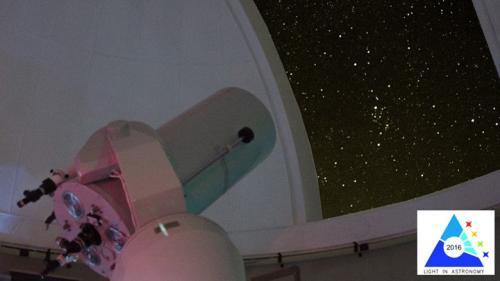
 ITALIANO
ITALIANO
Le origini dell'Osservatorio Astronomico risalgono al 1753, quando l'imperatrice d'Austria Maria Theresia istituì la Scuola Nautica di Trieste. Per alcuni decenni essa fu ospitata presso il locale Collegio dei gesuiti vicino alla chiesa di S. Maria Maggiore. Nella scuola veniva insegnata l'astronomia quale disciplina curricolare per la formazione dei capitani marittimi. Nel 1817 la scuola venne trasformata in Accademia di Commercio e Nautica e trasferita nella nuova grande sede di palazzo Biserino, nell'odierna piazza Hortis. Un vero e proprio osservatorio astronomico, sebbene a interim, fu installato nel 1851; esso divenne stabile nel 1866 come istituto della marina mercantile, incorporando poco dopo anche la stazione meteorologica. Nel 1898 l'Osservatorio si staccò definitivamente dall'Accademia, diventò autonomo e, diretto da Ferdinand Anton, si trasferì in un nuovo, grande edificio di cinque piani eretto con lo stile di un palazzotto medievale in periferia della città, preso in affitto. Si tratta del palazzo (detto castello) Basevi, tra il colle di San Giusto e quello di San Vito, dove l'Osservatorio tuttora risiede.
A partire dal 1999 l’Osservatorio Astronomico di Trieste e’ entrato a far parte dell’Istituto Nazionale di Astrofisica (INAF).
Dagli anni ’30 agli anni ’60 del secolo scorso molti osservatori italiani si posero il problema di allontanarsi dalle concentrazioni di luci urbane, pianificando l’erezione di stazioni osservative lontane dalle città. La stazione osservativa di Basovizza fu eretta a partire dal 1965 su volontà di Margherita Hack, all'epoca direttore dell'Osservatorio.
La Specola Margherita Hack, presso la stazione osservativa di Basovizza, è aperta alle visite del pubblico e delle scuole. Al piano terreno si trova l'allestimento della mostra storica che raccoglie numerosi testi, strumenti e notizie sull'attività scientifica degli astronomi triestini e giuliani dal 1750 al 1970, in un percorso temporale descritto passo per passo in italiano, inglese e tedesco. Al piano superiore, vale a dire nella cupola propriamente detta, è installato un moderno telescopio riflettore che ha lo specchio principale di 60 cm di diametro. Lo strumento, la sua meccanica e il suo sistema ottico sono ottimizzati per offrire la massima qualità e semplicità di visione diretta, non mediata da alcuna apparecchiatura elettronica, dei corpi celesti, visione che costituisce un'esperienza diversa da quella offerta dalle immagini su carta o schermo.
Per maggiori informazioni sulle attività dell'INAF-Osservatorio Astronomico di Trieste visitate il sito http://scuole.oats.inaf.it.
Non entrate all'Osservatorio, la cache si trova all'esterno. L'Osservatorio è aperto al pubblico solo durante le attività dedicate.
 ENGLISH
ENGLISH
The origin of the Astronomical Observatory of Trieste dates from 1753 when the Austrian Empress Maria Theresia established the Nautical School in the town of Trieste. For some decades the Nautical School was hosted in the Jesuit College near the church of Santa Maria Maggiore. Astronomy was part of the curricular subjects taught to future captains.
In 1817 the Nautical School became the Academy for Commerce and Navigation and was moved to a new and larger seat in Palazzo Biserino, located on today’s Piazza Hortis. In 1851 a real, though temporary, Astronomical Observatory was installed at the Academy. In 1866 the Astronomical Observatory was officially established as one of the Institutes of the Merchant Navy and a few years later merged with the Meteorological Station. In 1898 the Observatory was permanently separated from the Academy and became autonomous. The director was Ferdinand Anton and the seat was moved to the town periphery to a rented new and huge five-floor building with the aspect of a medieval palace. The building was palace Basevi, called Basevi castle, near the hills of San Vito and San Giusto, which still hosts the Observatory.
In 1999 the Astronomical Observatory of Trieste became one of the Institutes of the National Institute for Astrophysics.
During the 20th Century, for about three decades since the 30’s, a number of Astronomical Observatories in Italy faced the increasing problem of luminous pollution caused by urban settlements and planned observing stations in areas far from towns. The Basovizza observing station have been built starting from 1965 on the will of Margherita Hack, the Observatory director.
The Specola Margherita Hack, at the Basovizza observing station, is open to public and school visits. On the ground floor of the dome dedicated to Margherita Hack the new outfitting of the historical exhibition is located. It comprises several texts, instruments and news on the scientific work of astronomers of the area of Trieste and the Venezia Giulia from 1750 to 1970. The time itinerary is described step by step in Italian, English and German. On the first floor, inside the dome, a new 60 cm reflecting telescope has been installed. The telescope, as well as its mechanism and optical system, were optimized to offer the best quality and most simple direct vision of celestial bodies, without the filter of electronic instruments. Direct observation is a unique experience, very different from the usual way of watching images on the screen or on paper.
If you are interested on the activities of the INAF-Astronomical Observatory of Trieste dedicated to general public and schools, visit the web site http://scuole.oats.inaf.it.
Please do not enter the Observatory, it is open to the public only during outreach activities. The cache is outside.